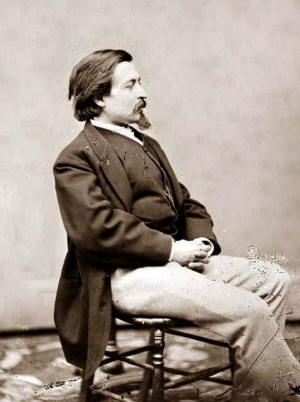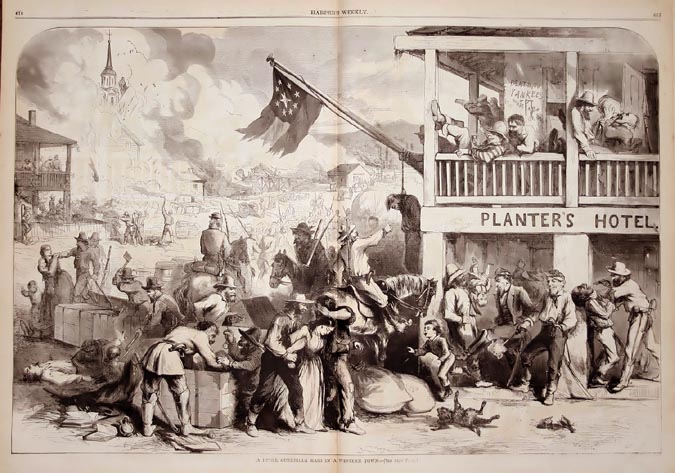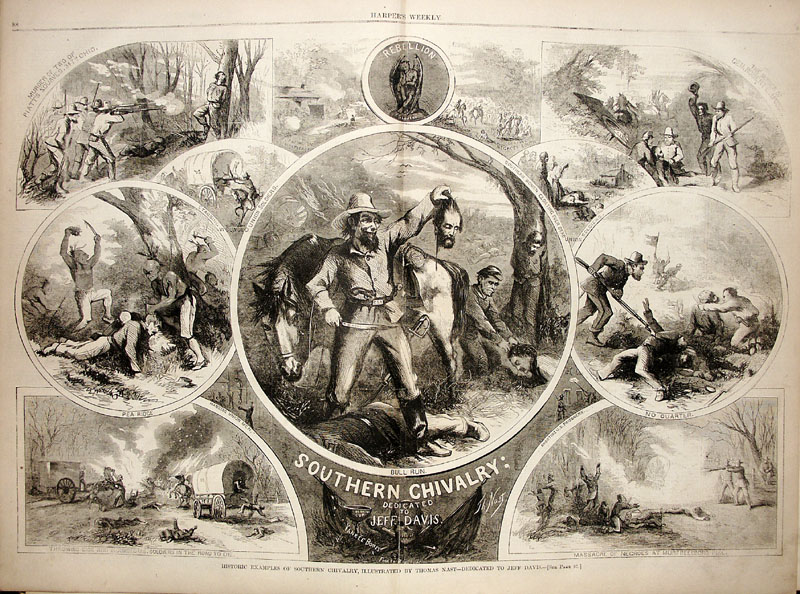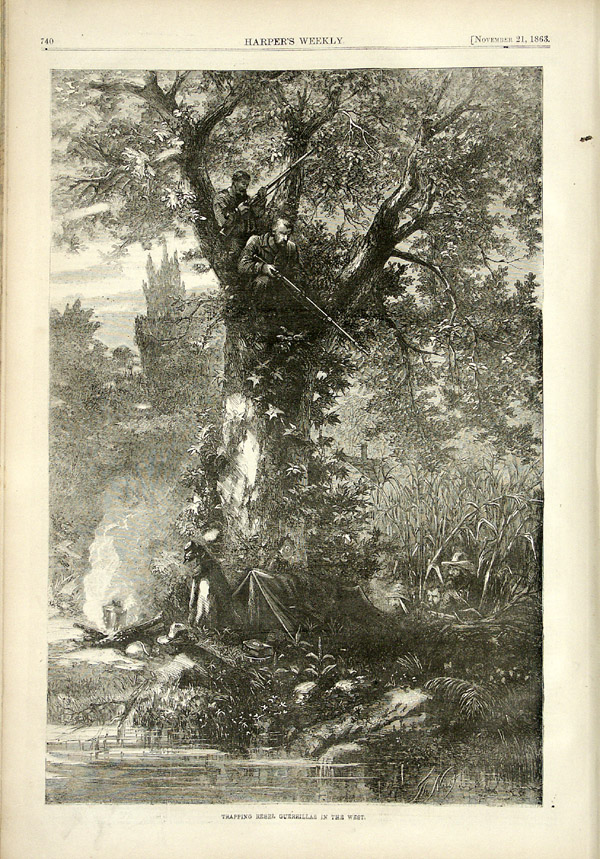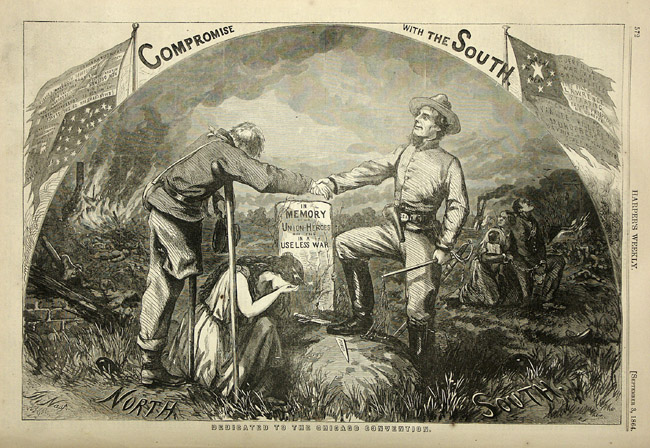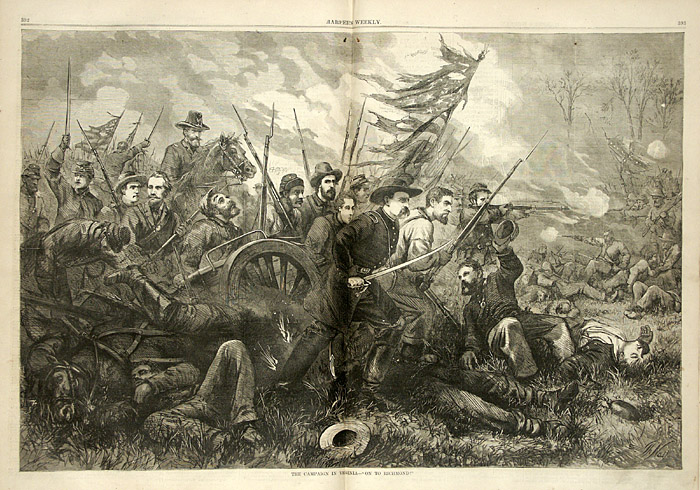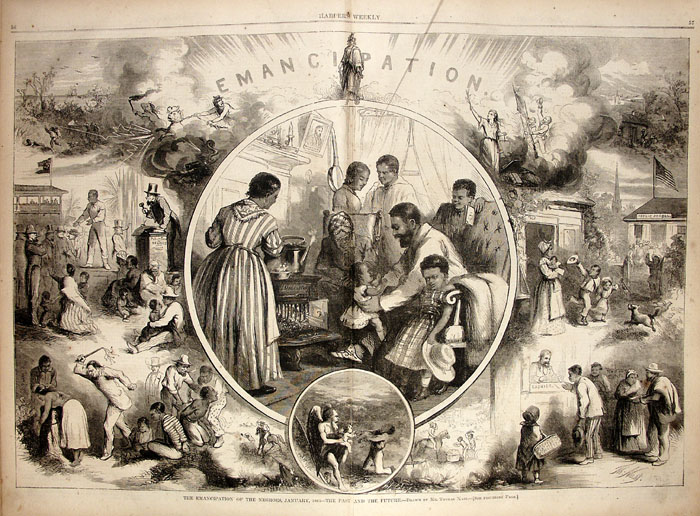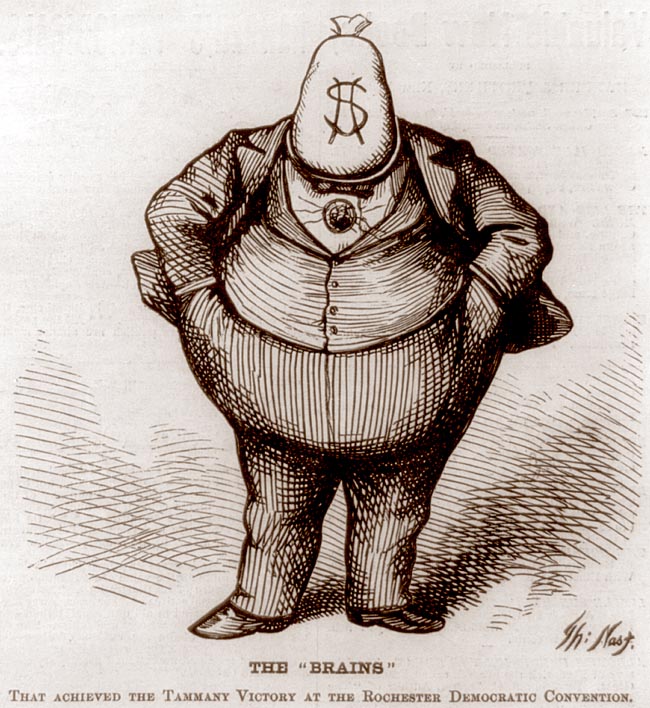Thomas Nast
![]()
This Site:
Starting a Collection
Top Picks
Online Gallery
Search Page
Order
Winslow Homer
Thomas Nast
Ken Burns Civil War
|
Works of Thomas Nast
|
|
|
Thomas Nast |
Thomas NastIt was novelist Edward Bulwer-Lytton who first said, “The Pen is Mightier than the Sword”, but it was artist Thomas Nast who demonstrated the profound truth of the adage. While Thomas Nast is almost forgotten today, there is perhaps no person of the latter half of the 1800’s who had a larger impact on defining American culture, and influencing American history. He was responsible for creating the popular American icons of the Republican Elephant, the Democratic Donkey, Uncle Sam, Santa Claus, and Columbia. His artwork played an instrumental role in securing Abraham Lincoln’s second election to the presidency, in the election of Ulysses S. Grant, and in the downfall of the corrupt political machine of Boss Tweed and Tammany Hall. |
|
Considering these impressive accomplishments, a more detailed examination of the life and work of Thomas Nast is warranted. Early Life and Work:Nast was born on September 27, 1840 in Germany. He relocated to New York City in 1846. He studied art in New York. He began work as an artist for Leslie’s illustrated in 1855, and for Harper’s Weekly in 1859. At this time, pictures were printed in newspapers through woodblock printing. A picture had to, in effect, be “carved” onto a block of wood, and then the wood block was used as a “stamp” to print the picture onto a page. In order to create these woodblock prints, photographs or other images had to first be converted into line art. Newspapers like Leslie’s and Harper’s had to hire artists to convert photographs into line art. The artists would look at a photograph, and then create a drawing of the photograph as accurately as possible. In this role, the artist was simply trying to duplicate the original photograph or artwork. It is likely that much of Nast’s early work for Leslie’s or Harper’s would have been in this vein, and likely these drawings would not be attributed to him by the newspapers. Emergence as an Artist and Political Commentator:Nast began to emerge as an artist, satirist, and political commentator (through his artwork), in 1862. His art was not only stunning in its visual impact; it was profound in its political message. The result of this unique combination of properties resulted in his artwork having an incredible ability to direct or steer public opinion. His work touched people, and impacted how they thought about a particular topic. During the Civil War years his work was staunchly pro Lincoln, pro Union, and anti Slavery. His artwork portrayed Southerners as the enemy . . . not just the enemy, but a cruel and barbarous people.
Thomas Nast Illustration of Quantrill's Raid on a Western TownThe drawing above, created in 1862, is an excellent example of Nast's early Civil War work. The drawing shows a scene of a Rebel raid on a Western town. The Southerners are portrayed as a barbarous group. The image shows the Confederate National Flag flying over the pillaging of a town. A white man is being lynched from the very flag pole flying the Confederate Flag. Drunk men are abusing the local women. Belongings are being pillaged. A black man is being murdered, a child is being abused, and even a child's dog is being shot, right in front of him. Illustrations such as this one inflamed passions in the North, and kept tempers enraged against the south. If there is any doubt that Nast portrayed the enemy as a cruel and heartless people, consider this next illustration.
Thomas Nast- Southern ChivalryThis drawing shows Rebel Soldiers decapitating defenseless Union prisoners. It also shows scenes of pillaging, murder, and other significant war crimes. Today, Nast is often remembered as a "Cartoonist". I feel that this designation is unfortunate, as it overlooks his significant talent as an artist. His Civil War artwork should not be considered "cartoons", but meaningful artwork. The drawing below shows Nast's talent as an artist.
Trapping Rebel Guerrillas in the West - Thomas NastThis illustration shows two Union sharpshooters poised in a tree above the camp of unsuspecting Rebels. As the Civil War dragged on, public support for the war diminished. The war was viewed as a "cragmire", and Lincoln was viewed as being aloof and incompetent. By September 1864, even Lincoln himself was doubtful that he would be reelected. The Democrats were running General George McClellan against Lincoln. They were running on a platform of Compromise with the South. The platform basically said that it was time to get out of the war, and the path to end the war was to compromise with the south. The key element that the Democrats wanted was to end the war, and preserve the union (hopefully). They were willing to give in on the issue of slavery, and let the south continue to hold slaves, if they would end the war. At this point everyone in the North had either lost a loved one in the war, or knew someone who lost a loved one in the war. There appeared to be no end in site, and the proposition of a quick end to the war, through compromise, was extremely appealing. It was at this critical point that Nast created the following illustration.
Thomas Nast: Compromise with the SouthThis drawing inflamed passions in the North. The picture is titled, "Compromise with the South", which was the democratic campaign platform for the 1864 election. The illustration showed what the slogan really meant. The picture shows a defeated, injured union soldier bowing down, and shaking hands with a victorious rebel soldier. The rebel is standing with his boot on the grave of a fallen union soldier. The tombstone reads, "In Memory of Union Heroes Who Died in a Useless War". Lady Liberty is seen kneeling at the grave, and crying. Two months later, Lincoln defeats McClellan, and is elected to a second term as President of the United States. Many feel that this illustration helped propel Lincoln to victory in the 1864 presidential election. As the North finally began to achieve military success in the War, and as it began to look like victory could be achieved, Nast released this rousing illustration.
Thomas Nast: On to RichmondThis is an inspirational drawing, showing determined Union soldiers on their path to capturing Richmond. As the soldiers push onward, some are seen falling, yet still waiving their comrades onward to victory. This picture sent a clear message that the end was in sight, and victory could be achieved. Nast's Civil War artwork was clearly supportive of Lincoln, supportive of the war effort, and supportive of the preservation of the Union. These were, in effect, the easy causes for Nast to get behind. A more difficult issue was the issue of slavery. While slavery was practiced in the South, many people either directly or indirectly benefited from it in the North. Slavery enabled cheap cotton, and hence textiles. It also enabled cheap tobacco and agricultural products. Many in the North were willing to look the other way, and ignore the cruelty of the institution of slavery. This attitude was helped by the fact that at the time, slaves were always discussed in the context of being property, not people. While it is true that there was a vibrant abolitionist movement underway in the North, the movement had such radical elements that for the most part it frightened people. So, most people thought of slaves in much the way they thought of cattle, horses, or other farm commodities. Nast wanted to change the view towards slaves, without blatantly offending or frightening people. He did this by creating artwork that helped show slaves as people, not property, and show the fundamental cruelties associated with the institution of slavery. A good example of this type of artwork is displayed below.
Thomas Nast: EmancipationHis artwork was revolutionary in that it portrayed Slaves as People, not as Property. The artwork of Nast helped accomplish what the more radical abolitionist movement had not been able to do; it helped the general population see and appreciate the basic humanity of the slave population. The illustration above is an excellent example of how Nast used his artwork to help redefine the way people looked at slaves and slavery. The center of the illustration shows a revolutionary picture of the possibilities of the future, while the insets surrounding the central image show the cruel realities of the past. The center illustration is revolutionary in that it shows a black family in what would be a typical scene of a white family of the day. They are living in a nice home, with nice furniture, and nice clothes. The father is bouncing his little child on his leg. The family is doing all the normal things a white family of the day would have been doing. This would have been somewhat shocking when this illustration was made . . . it is portraying Black People as Normal People, not as property. While the central image helps people see Slaves as People, the surrounding images capture the brutality of the institution of slavery. It shows black women being tied up and beaten, it shows black men being tortured, and is shows escaped slaves being hunted down like dogs. A particularly poignant image shows a family being auctioned off at a slave auction. The upper part of the illustration shows spiritual beings . . . some from the pit of hell, and some looking as if they are heavenly creatures. This part of the drawing clearly portrays Nast's view that the issue was a spiritual conflict . . . a conflict of good vs. evil, with the battle extending all the way to the spiritual realm. Post War Years:Nast became very famous due to the popularity of his Civil War artwork, some of which we have presented above. He became a sought after book illustrator, and speaker. He is said to have illustrated over 100 books. Nast was always one to take on a cause when he felt that there was an issue of right vs. wrong. In 1868 he became involved in an effort to oust the corrupt New York City government of Tammany Hall led by Democratic politician "Boss" Tweed.
Nast's drawings depicted Boss Tweed as a corrupt politician. Nast's attacks were so relentless that at one point Tweed dispatched his cronies with instructions to, "Stop them damn pictures. I don't care what the papers write about me. My constituents can't read. But, damn it, they can see the pictures." It was also reported that Tweed offered Nast bribes to "take an extended European vacation" in order to try and get the pictures to stop. Tweed and his corrupt counterparts were ousted from office in November of 1871. An irony of history is that when Tweed escaped from jail and fled to Spain in 1876, he was recognized and arrested by a customs official who did not read English but had seen Nast's Harper's Weekly caricatures of Tweed. In 1872, Nast turned his pen against Horace Greely. During the Civil War, Greeley had been one of the Nation's most vocal critics of Lincoln, and opponent of the war. Nast's drawings this time helped U.S. Grant's presidential campaign. In 1877 Nast's influence would rapidly decline. He had been given almost free reign on the pages of Harper's Weekly from 1862 to 1877. In 1877 Fletcher Harper, the magazine's publisher died. Joseph Harper became the publisher, and wanted to make the publication less political and of greater general appeal. As such, they began to reign in Nast. He eventually quit over issues of artistic integrity. Nast then began work as a freelance illustrator, and even tried his hand at publishing a magazine. These efforts met with limited success. In 1902 he accepted Theodore Roosevelt's appointment to serve as consul general to Ecuador. After six months he contracted yellow fever and died on December 7, 1902. After his death Harper's Weekly wrote that he belonged ".
. . so much to the past that the impression has naturally spread that he was
an old man." Nast was, in fact, only sixty-two when he died, a giant in the
history of American Art who found himself out of step with changing times. Ohio State Biography on Nast, www.lib.ohio-state.edu. Encycl. Brit. 1911 Harper's Weekly, 1861-1872 |
|
![]()
|
Email us at: paul@sonofthesouth.net. Copyright © 2003-2018 Son of the South.
|
|
|
|
Are you Scared and Confused? Click Here to read My Snake Story, a story of hope and encouragement, to help you face your fears. |
||
